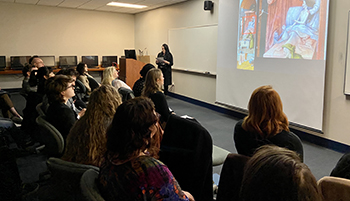A Lexical Analysis of Contemporary American White Nationalist Language
Description/Abstract/Artist Statement
I conducted lexical analysis of contemporary American white nationalist language as part of a research team, People Educating Citizens Against Racism (PECAR), directed by Dr. Bridget Anderson. I was an analyst and project manager for a team of students that worked with a large corpus of Discord chat room language used to plan the deadly Unite the Right White Nationalist rally held in Charlottesville, Virginia in August 2017. The data includes colloquialisms, lexical items, and insider knowledge of White Nationalist groups. We built a lexicon, similar to a dictionary, to bring clarity and understanding to the unfamiliar words/terms that are found in Nazi language. Lexical items include neologisms, or new words, such as “dindu,” used as a derogatory term for African Americans in reference to their dialect when saying “didn’t do nothing.” Some meanings of standard words have been newly specified, for example “bowlcut,” to describe a person who has committed/aspires to commit a racially motivated violent act who is inspired by Dylann Roof. The lexicon catalogues groups (e.g. Identity Evropa, Vanguard America, the Rise Above Movement (RAM), etc., slang (Chad: a way to describe a “pretty boy” or “typical white guy”, Jewing: synonymous with “messing up”), and derogatory terms (Mudslimes, Cotton Candy). The SPLC tracks over 1,000 hate groups across the nation. My paper presents an analysis of a contemporary Nazi lexicon and provides chilling evidence that hate groups are alive and well in our society today. The public deserves to be informed.
Faculty Advisor/Mentor
Bridget Anderson
Presentation Type
Oral Presentation
Disciplines
English Language and Literature | Modern Languages | Race, Ethnicity and Post-Colonial Studies
Session Title
College of Arts & Letters 2
Location
Learning Commons @ Perry Library Conference Room 1311
Start Date
2-8-2020 10:15 AM
End Date
2-8-2020 11:15 AM
A Lexical Analysis of Contemporary American White Nationalist Language
Learning Commons @ Perry Library Conference Room 1311
I conducted lexical analysis of contemporary American white nationalist language as part of a research team, People Educating Citizens Against Racism (PECAR), directed by Dr. Bridget Anderson. I was an analyst and project manager for a team of students that worked with a large corpus of Discord chat room language used to plan the deadly Unite the Right White Nationalist rally held in Charlottesville, Virginia in August 2017. The data includes colloquialisms, lexical items, and insider knowledge of White Nationalist groups. We built a lexicon, similar to a dictionary, to bring clarity and understanding to the unfamiliar words/terms that are found in Nazi language. Lexical items include neologisms, or new words, such as “dindu,” used as a derogatory term for African Americans in reference to their dialect when saying “didn’t do nothing.” Some meanings of standard words have been newly specified, for example “bowlcut,” to describe a person who has committed/aspires to commit a racially motivated violent act who is inspired by Dylann Roof. The lexicon catalogues groups (e.g. Identity Evropa, Vanguard America, the Rise Above Movement (RAM), etc., slang (Chad: a way to describe a “pretty boy” or “typical white guy”, Jewing: synonymous with “messing up”), and derogatory terms (Mudslimes, Cotton Candy). The SPLC tracks over 1,000 hate groups across the nation. My paper presents an analysis of a contemporary Nazi lexicon and provides chilling evidence that hate groups are alive and well in our society today. The public deserves to be informed.

